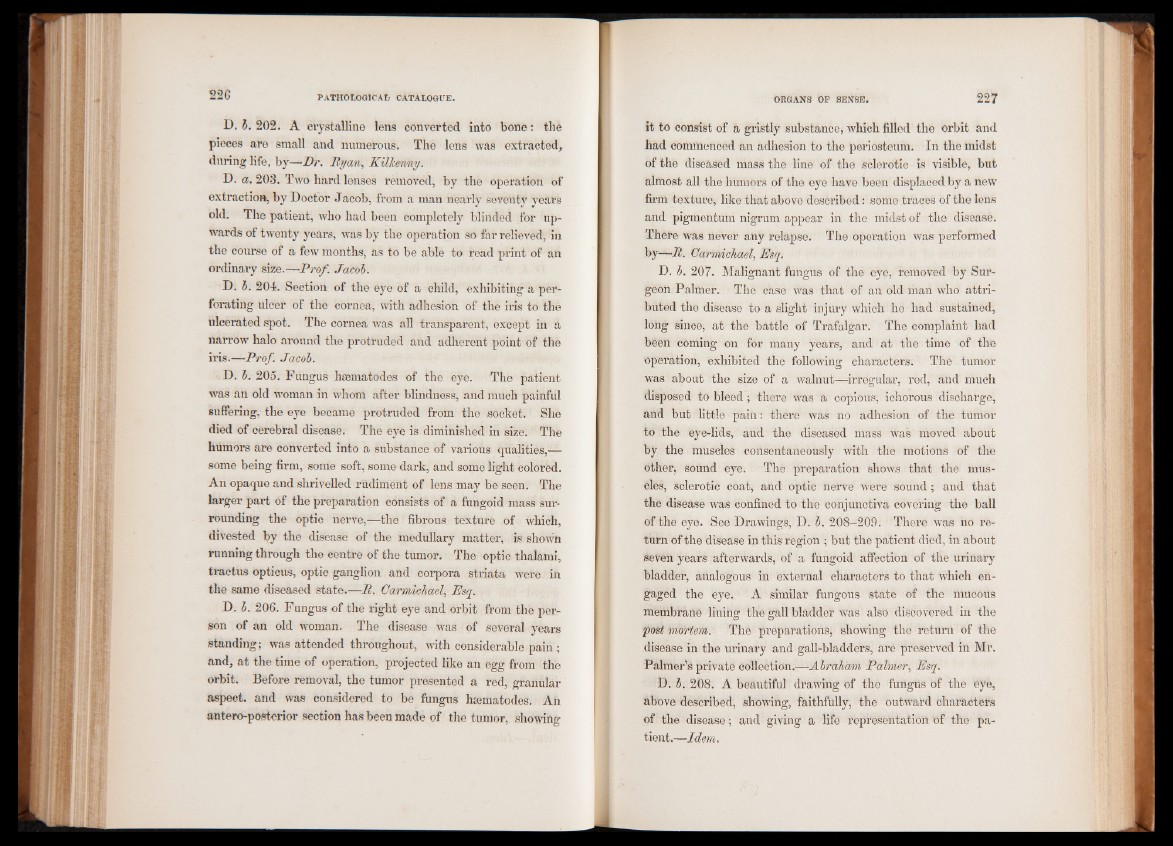
D. i. 202. A crystalline lens converted into bone: the
pieces are small and numerous. The lens was extracted,
during life, by—Dr. Ryan, Kilkenny.
D. a. 208. Two hard lenses removed, by the operation of
extraction, by Doctor Jacob, from a man nearly seventy years
old. The patient, who had been completely blinded for upwards
of twenty years, was by the operation so far relieved, in
the course of a few months, as to be able to read print of an
ordinary size.—Prof. Jacob.
D. b. 204. Section of the eye of a child, exhibiting a perforating
ulcer of the cornea, with adhesion of the iris to the
ulcerated spot. The cornea was all transparent, except in a
narrow halo around the protruded and adherent point of the
iris.—Prof. Jacob.
D. b. 205. Fungus hsematodes of the eye. The patient
was an old woman in whom after blindness, and much painful
suffering, the eye became protruded from the Socket. She
died of cerebral disease. The eye is diminished in size. The
humors are converted into a substance of various qualities,—
some being firm, some soft, some dark, and some light colored.
An opaque and shrivelled rudiment of lens may be seen. The
larger part of the preparation consists of a fungoid mass surrounding
the optic nerve,—the fibrous texture of which,
divested by the disease of the medullary matter, is shown
running through the centre of the tumor. The optic thalami,
traetus opticus, optic ganglion and corpora striata were in
the same diseased state.—R. Carmichael, Esq.
D. b. 206. Fungus of the right eye and orbit from the person
of an old woman. The disease was of several years
standing; was attended throughout, with considerable pain ;
and, at the time of operation, projected like an egg from the
orbit. Before removal, the tumor presented a red, granular
aspect, and was considered to be fungus luematodes. Ah
antero-posterior section has been made of the tumor, showing
it to consist of a gristly substance, which filled the orbit and
had commenced an adhesion to the periosteum. In the midst
of the diseased mass the line of the sclerotic is visible, but
almost all the humors of the eye have been displaced by a new
firm texture, like that above described: some traces of the lens
and pigmentum nigrum appear in the midst of the disease.
There was never any relapse. The operation was performed
by—R. Carmichael, Esq.
D. b. 207. Malignant fungus of the eye, removed by Surgeon
Palmer. The case was that of an old man who attributed
the disease to a slight injury which he had sustained,
long since, at the battle of Trafalgar. The complaint had
been coming on for many years, and at the time of the
operation, exhibited the following characters. The tumor
was about the size of a walnut—irregular, red, and much
disposed to bleed; there was a copious; ichorous discharge,
and but little pain: there was no adhesion of the tumor
to the eye-lids, and the diseased mass was moved about
by the musdes consentaneously with the motions of the
other, sound eye. The preparation shows that the muscles,
sclerotic coat, and optic nerve were sound ; and that
the disease was confined to the conjunctiva covering the ball
of the eye. See Drawings, D. b. 208-209. There was no return
of the disease in this region ; but the patient died, in about
Seven years afterwards, of a fungoid affection of the urinary
bladder, analogous in external characters to that which engaged
the eye. A similar fungous state of the mucous
membrane lining the gall bladder was also discovered in the
post mortem. The preparations, showing the return of the
disease in the urinary and gall-bladders, are preserved in Mr.
Palmer’s private collection.—Abraham Palmer, Esq.
D. b. 208. A beautiful drawing of the fungus of the eye,
above described, showing, faithfully, the outward characters
of the disease; and giving a life representation of the patient.—
Idem.